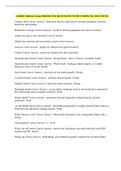Exam (elaborations)
LQB182 MidSem Exam| PREDICTED QUESTIONS| WITH COMPLETE SOLUTIONS
- Course
- Institution
Valance shell Correct Answer: Outermost electron shell and its electrons determine chemical behaviour and bonding Radioactive isotopes Correct Answer: Useful in medical diagnostic tests and in research Atoms can gain or lose electrons Correct Answer: Metals lose electrons and non-metal...
[Show more]



